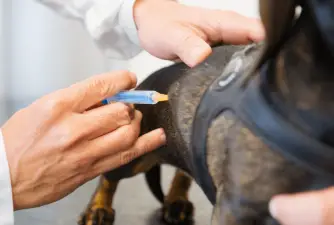Distemper in Dogs - How Can Dogs Get It?
20.09.2021.
One of the things new dog owners and breeders worry about is canine distemper. This is a terrible contagious disease that often ends up in the worst possible way - death. It is crucial that puppies get protected from distemper, which is why you should never skip vaccinations. If you want to know a bit more about this terrible disease, stay with us a bit more.
What is canine distemper?
Canine distemper is a multisystemic (affects different organs) incurable viral disease that can infect dogs, raccoons, ferrets, and skunks. This highly contagious disease will affect the dog’s respiratory, gastrointestinal, and central nervous systems. The canine distemper virus causes it, and it is one of the worst diagnosis a dog can get.
How can dogs get distemper?
One of the reasons this disease is so effective is because it spreads rapidly. Healthy, unvaccinated dogs need to get in contact with an infected dog’s body fluids. The virus is contagious even before the infected dog starts showing symptoms, so it is absolutely crucial all puppies get vaccinated. Coughing and sneezing is a quick way an infected dog can spread the disease.

Distemper symptoms
If you are worried your dog was in contact with another dog infected with distemper, you should immediately call your vet. Let them know you suspect distemper cases, and you should also alert animal control. This is not something that should be taken lightly, and there were cases where entire kennels suffered tremendous losses because of this disease. Keep in mind that the disease can take up to 14 days to fully develop, and symptoms will not show immediately after exposure. The most common distemper symptoms are;
- Fever
- Sneezing
- Coughing
- Lethargy
- Breathing issues
- Nasal and eye discharge
- Pneumonia
- Thickening of nose and pads
- Skin sores
- Pain
These are physical symptoms that the virus usually attacks first. The respiratory and gastrointestinal systems are weaker than the central nervous system, so neurological disorders can take some time to develop. However, when they do finally develop, the most common distemper-caused neurological symptoms are;
- Twitching
- Excessive salivation
- Head tilting
- Circling
- Seizures
- Involuntary eye movements
- Partial or full paralysis

One of the potential problems with this disease is that neurological signs often manifest late. This disease is often misdiagnosed because there are many infections and diseases that can cause respiratory and gastrointestinal issues. Make sure you notify your vet if you’re not sure about your dog’s vaccination history.
How is distemper treated?
Viral infections are impossible to treat. The only thing vets can do is treat symptoms that occur. For example, if a dog gets a high fever, vets can focus on getting that down and make sure the dog is adequately hydrated. There is no cure for distemper. The usual thing vets advise is hospitalization and intensive care. In some cases, dogs need antiseizure medication, IV fluids, and antibiotics for bacterial infections that usually follow the distemper infection.
What is the prognosis for dogs with distemper?
The prognosis for dogs infected with this terrible disease is not really good. Puppies are more susceptible to distemper than adult dogs. Most cases of distemper in puppies end up with the unfortunate puppy’s death. Adult dogs can survive the infection, but they will most likely develop crippling neurological and physical disorders that will make their lives a lot harder. Dogs that survive this disease often get seizures or long-lasting pneumonia.
VET TIP: The distemper virus can stay in the dog’s body for 6 months. That makes isolation incredibly hard, and the chances of the virus spreading are higher.
Can it be prevented?
Here comes the part with some good news - yes, distemper can be prevented. One of the best things that ever happened to dogs was the invention of the distemper vaccination. You have to listen to your vet and make sure your dog gets the necessary vaccination. You don’t want to risk your dog’s health and gamble with their life.

The initial immunization starts when the puppy is 8 weeks old. After that, the first booster shot is given to the puppy after 4 weeks (12-week-old). The third booster is given after another 4 weeks (16-week-old). Some vaccinations are highly effective and were approved for three-year intervals. That means adult dogs need to get a distemper booster shot every 3 years.
If you want to know more about dog vaccinations, check out this article - Puppy shot schedule.
In conclusion
Canine distemper is a severe disease that should never be taken lightly. Luckily, after the 1970s, the virus became a lot less common because of the canine distemper vaccination. However, it still survives in wild animals, and we need to make sure our dogs are protected through vaccinations.
World Dog Finder team







Share